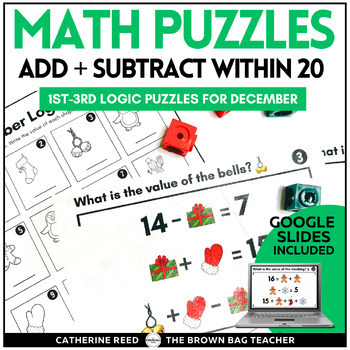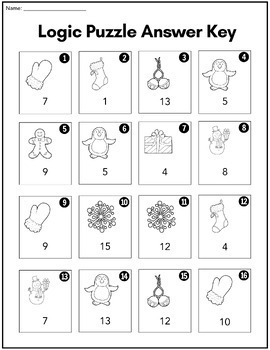December Math Logic Puzzles: Addition & Subtraction within 20
- PDF
What educators are saying
Description
Addition and Subtraction Logic Puzzles for December and Christmas. Perfect for practicing doubles, missing addends, and early finishers! These holiday-themed puzzlers are ideal for math enrichment and challenge!
So often it seems that finding just-right resources for all of our learners is a full time job, especially for our highest group of mathematicians. These are the friends working a grade-level (or two) above 1st grade and the ones who sometimes struggle to show growth on District Assessment programs (STAR, MAP, iReady, etc.). The question becomes - How do I challenge these students and move them forward?
When offering math challenges, students need to apply their math skills in flexible and unconventional ways. Students have to routinely ask themselves “Does my answer make sense?” as well as, be able to justify their answers.
INCLUDED IN THIS RESOURCE
16 Logic Puzzles & Answer Keys
Ready to Display Google Slides
3 Recording Log Options
The tasks in this resource require students to find the unknown value December-themed shapes. When working with these problems, students are intertwining their understandings of addition, subtraction, doubles, missing addends, and
commutative property.
I would suggest using these cards in small group before placing them in a center. Initially, my 1st grade friends panicked. As a group we talked using growth-mindset language and continuing trying numbers until students discovered patterns in the cards and between the numbers. I did want and let my students struggle. If supported too much, these brain teasers won’t be difficult. Accomplishing difficult tasks allows students to develop a mindset of growth and resilience. Students know it’s okay to make mistakes, try the wrong number, or unknowingly defend the wrong number. The sense of accomplishment when students complete a puzzle task (sometimes taking up to 15-20 minutes) is significant. Now, my highest mathematicians beg for these cards and love the challenge. Our motto has quickly become, “Our brains love to do hard things.
✅Download the preview to get a closer look at these templates and examples from my classroom!
___________________________________
Having difficulty with a file?
Visit the FAQs section, submit a help ticket, or ask a question on the Q& A tab before leaving feedback.
___________________________________
Copyright © Catherine Reed, The Brown Bag Teacher
Permission to copy for single classroom use only.
Please purchase additional licenses if you intend to share this resource.
***For other math resources, check out my Math Puzzlers Set #2, Math Puzzlers Set #3, Primary Math Centers, and Differentiated 120s Chart.





